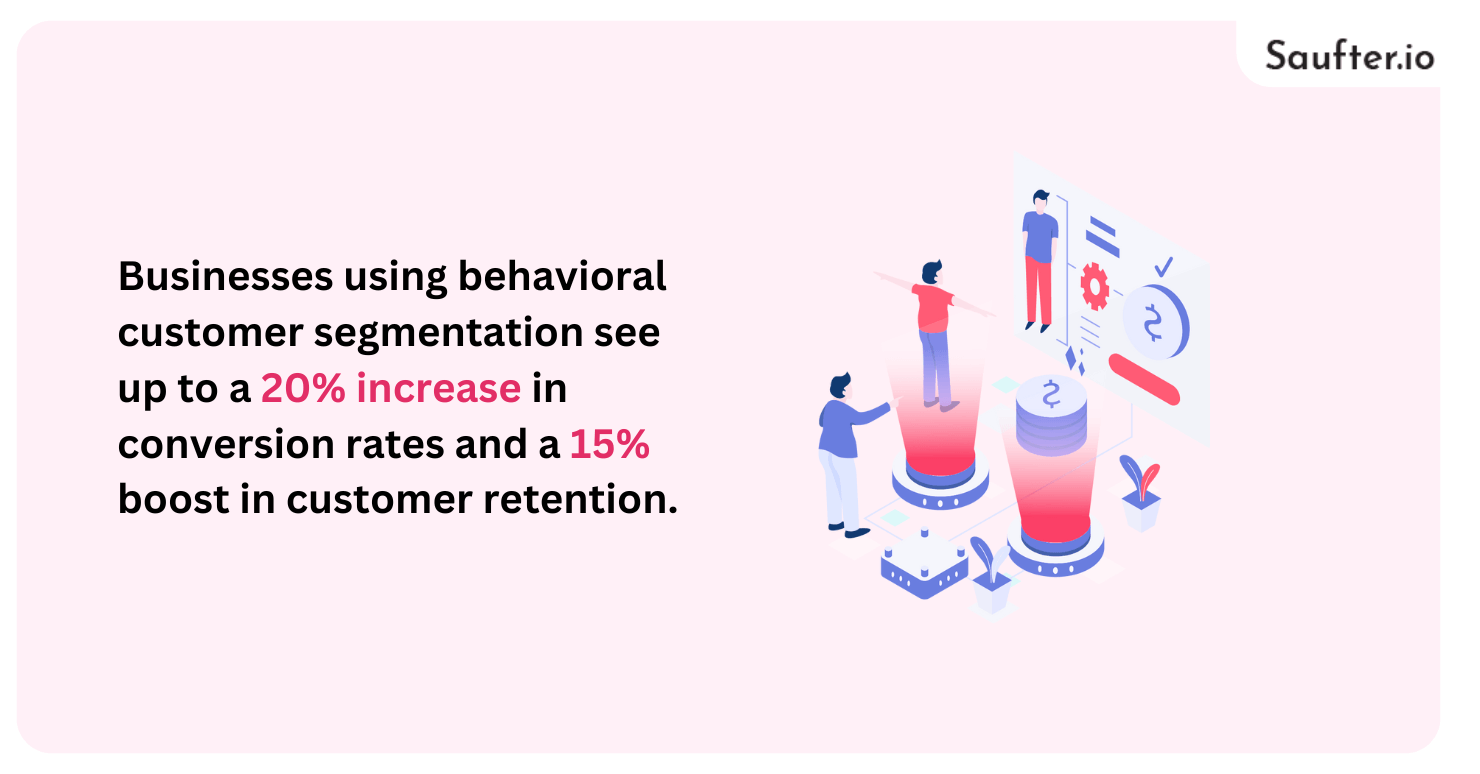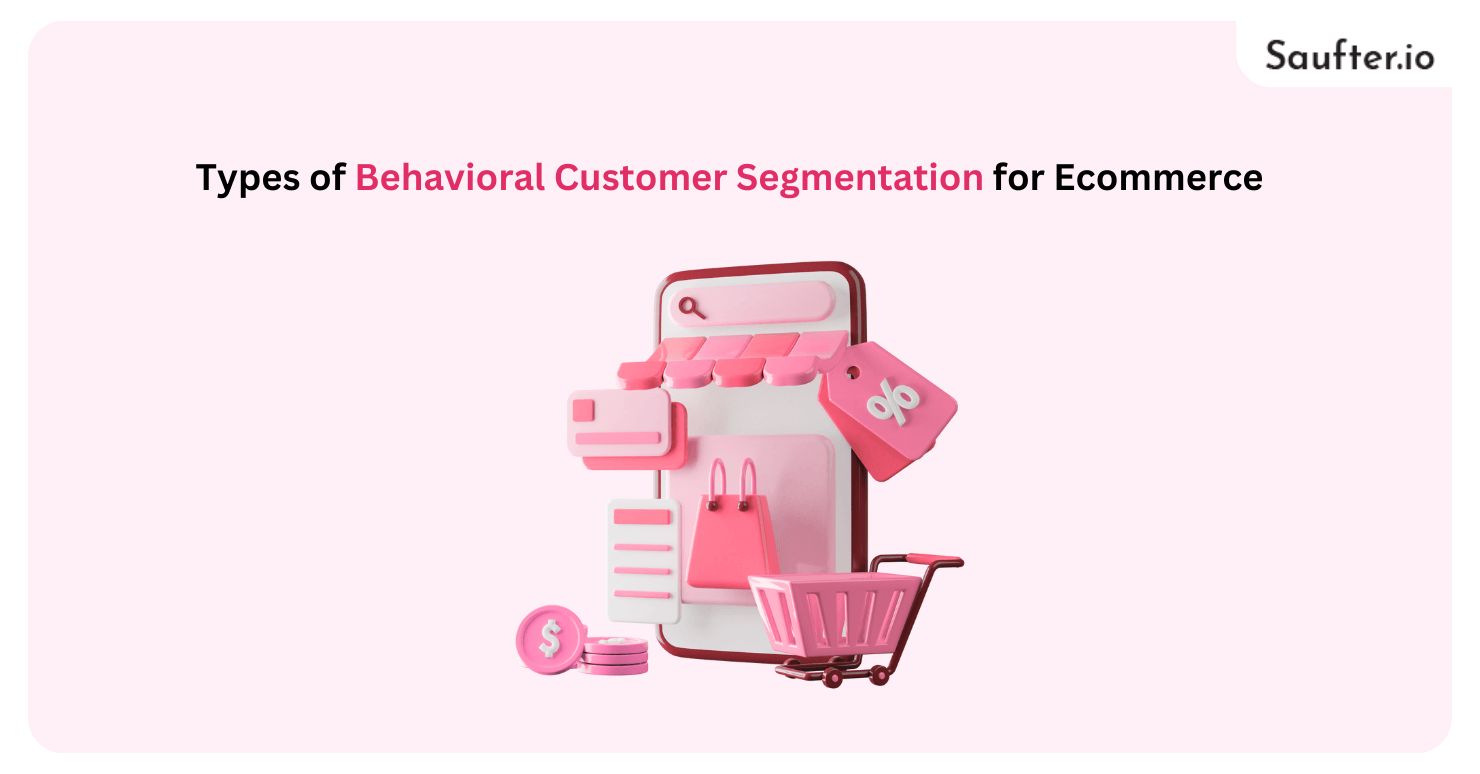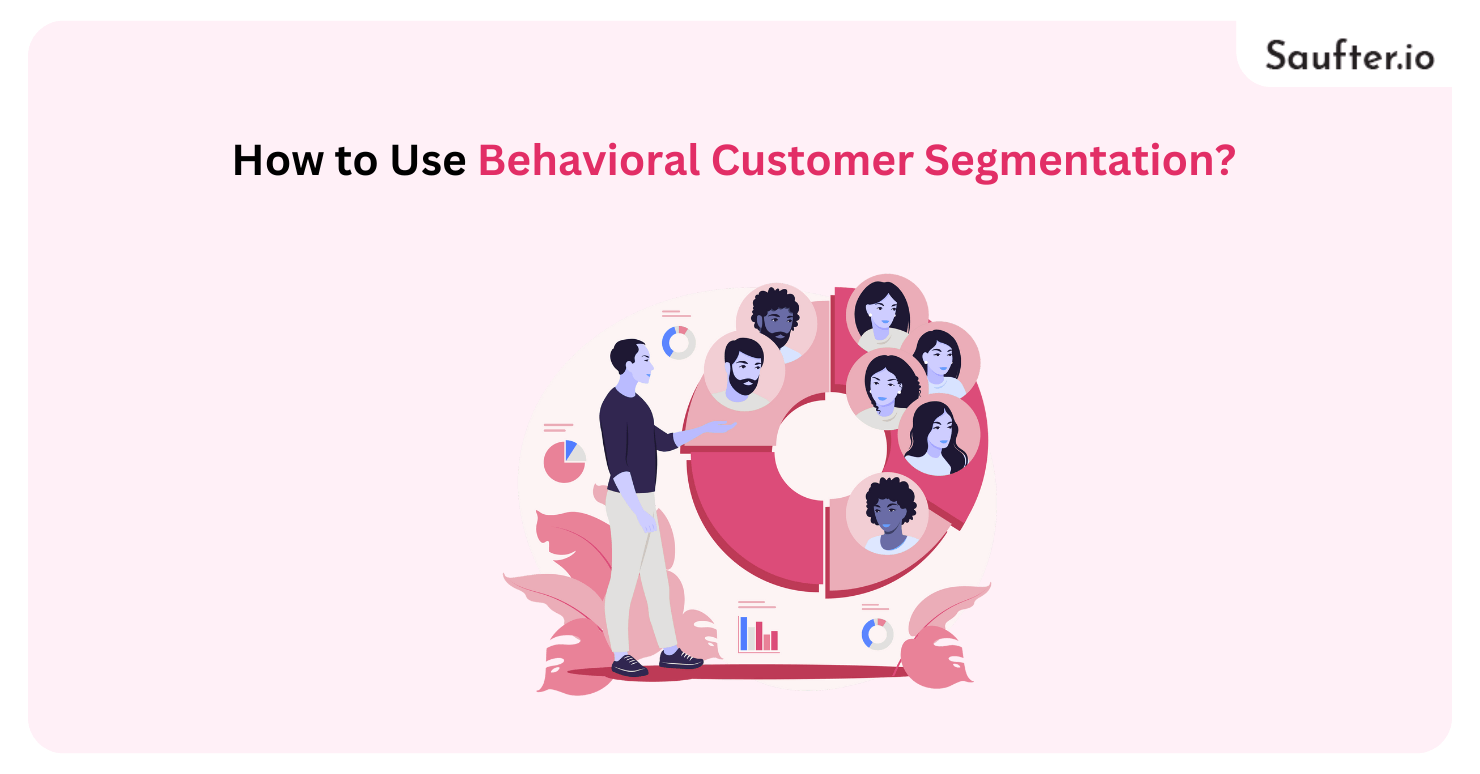Last Updated: December 2025
Imagine stepping into a cozy boutique where the shopkeeper greets you by name, knows your favorite styles, and suggests items that feel made for you. That’s the magic of behavioral customer segmentation, a strategy that brings this level of personalization to ecommerce. In a digital world where face-to-face connection is scarce, understanding how customers interact with your brand is like having a superpower.
 According to a 2023 McKinsey study, businesses using behavioral customer segmentation see up to a 20% increase in conversion rates and a 15% boost in customer retention. By focusing on what customers do rather than who they are, you can craft tailored experiences that drive loyalty and sales.
According to a 2023 McKinsey study, businesses using behavioral customer segmentation see up to a 20% increase in conversion rates and a 15% boost in customer retention. By focusing on what customers do rather than who they are, you can craft tailored experiences that drive loyalty and sales.
This guide breaks down behavioral customer segmentation, explores five key types for ecommerce, and shares practical ways to engage each segment with real-world strategies. Whether you’re a small business or a growing brand, these insights will help you connect with customers more effectively.
What is Behavioral Customer Segmentation?
Behavioral customer segmentation involves grouping customers based on their actions, how they browse your website, make purchases, leave reviews, or even abandon their carts. Unlike demographic segmentation, which focuses on age, gender, or location, this approach zeroes in on behavior, revealing intent and preferences. These patterns are gold for ecommerce brands where physical cues are absent.
By analyzing them, you can create messages and offers that feel personal, boosting engagement and sales.
This method is powerful because it’s dynamic. Customers’ behaviors evolve, and behavioral customer segmentation lets you adapt quickly, ensuring your marketing stays relevant. Let’s explore five types of behavioral customer segmentation that ecommerce businesses can use to unlock growth.
5 Types of Behavioral Customer Segmentation for Ecommerce

1. Website Behavior Segmentation
Among the types of behavioral segmentation, this one focuses on how customers navigate your website. You can group users based on actions like browsing specific product categories, lingering on certain pages, or frequently returning to your homepage. For example, someone who views multiple products but doesn’t buy is likely window-shopping, while a user who abandons a cart is closer to purchasing.
Use Cases:
- Window shoppers: Display exit-intent popups with a small discount or helpful product tips to nudge them toward a purchase.
- Engaged browsers: Send browse abandonment emails with recommendations based on their viewed products.
- Cart abandoners: Trigger reminder emails with urgency-driven messages, like “Your cart expires soon!” or offer free shipping.
2. Purchase Behavior Segmentation
This approach groups customers by their buying habits, how often they purchase, when they shop, or what motivates their decisions. You might identify high-frequency shoppers who buy regularly, deal hunters who wait for sales, or bulk buyers with recurring needs.
Use Cases:
- Loyal customers: Reward them with exclusive perks, like VIP discounts or early access to new products.
- First-time buyers: Follow up with a “thank you” email and a special offer to encourage a second purchase.
- Discount-driven buyers: Alert them about flash sales or limited-time promotions to capitalize on their deal-seeking behavior.
3. Customer Lifecycle Segmentation
This method categorizes customers based on their stage in the customer journey, from discovering your brand to becoming loyal fans. Common stages include new visitors, consideration-phase users, first-time buyers, and repeat customers.
Use Cases:
- New visitors: Send a warm welcome email series that shares your brand’s story and values.
- Considerers: Provide product comparisons, FAQs, or customer testimonials to address their research needs.
- Buyers: Enhance post-purchase engagement with order updates, review requests, or referral incentives.
4. Interest-Based Segmentation
This type groups customers by what grabs their attention, often based on their interactions with your social media, newsletters, or community content. You might identify eco-conscious shoppers who engage with sustainability posts, practical buyers focused on functionality, or trend-lovers who chase new releases.
Use Cases:
- Lifestyle-aligned customers: Share behind-the-scenes content or stories that resonate with their values.
- Practical buyers: Highlight how-to guides or real-world use cases for your products.
- Trendsetters: Offer sneak peeks or limited-edition drops to keep them excited.
5. Satisfaction-Based Segmentation
This approach focuses on customer happiness, using data from reviews, returns, referrals, or complaints. You can segment customers into promoters who rave about your brand, passive users who are neutral, or unhappy customers with issues.
Use Cases:
- Promoters: Encourage them to refer friends or leave reviews with rewards like discounts or loyalty points.
- Passive users: Re-engage them with personalized surveys or small incentives to spark interest.
- Unhappy customers: Respond swiftly with apologies, solutions, or compensation to rebuild trust.
How to Engage Different Behavioral Segments
Engaging Website Behavior Segments
Use tools like popups, personalized email flows, or chatbots to act on user intent in real time. For example, send browse abandonment emails to re-engage shoppers who viewed products but didn’t buy. For cart abandoners, create urgency with messages like “Only a few left in stock!” or offer limited-time deals like free shipping to seal the deal.
Engaging Purchase Behavior Segments
Build loyalty programs to reward frequent shoppers with points or exclusive offers. For one-time buyers, automate re-engagement emails with product suggestions based on their purchase history. Create separate promo lists for deal-seekers, ensuring they get timely sale notifications.
Engaging Customer Lifecycle Segments
Craft a welcome journey for new subscribers, focusing on education and brand values. For users in the consideration phase, share demos or testimonials to address their questions. After a purchase, send post-purchase emails with tracking info, review prompts, or referral options to deepen engagement.
Engaging Interest-Based Segments
Tailor newsletters to match user interests, send eco-friendly content to sustainability fans or trending picks to fashion-forward shoppers. Use social retargeting ads based on browsing categories or wishlists. Create promotions like “Top functional picks” or “This week’s hottest trends” to appeal to specific groups.
Engaging Satisfaction-Based Segments
Invite happy customers to share reviews or stories, offering small rewards for their effort. For neutral users, spark loyalty with personalized offers or feedback requests. For unhappy customers, prioritize quick resolutions, Studies show 70% of customers will return if their issue is resolved promptly.
Take Segmentation Further with Advanced Tools
Platforms like Klaviyo or HubSpot let you combine behaviors for hyper-targeted segments. For example, you could target “engaged email subscribers who haven’t purchased in 30 days” or “high spenders who haven’t reviewed a product.” By layering data points, your campaigns become precise, moving away from generic blasts to personalized conversations.
These tools also enable automation, saving time while maintaining a personal touch. You can set up flows that trigger based on specific actions, like a cart abandonment or a repeat purchase, ensuring every customer feels seen.
How to Use Behavioral Customer Segmentation

Implementing behavioral customer segmentation starts with a smart behavioral marketing strategy that turns customer actions into opportunities. First, collect data using tools like Google Analytics, Klaviyo, or Shopify to track behaviors such as page views, purchase frequency, or email opens. This data is the foundation of your behavioral marketing strategy, helping you understand what drives your customers.
Next, identify key behaviors to segment. For example, are customers abandoning carts, browsing specific categories, or making repeat purchases? Group them into meaningful segments like cart abandoners, frequent buyers, or window shoppers. A strong behavioral marketing strategy prioritizes segments with the highest potential impact, such as re-engaging cart abandoners to recover lost sales.
Then, craft personalized campaigns. For cart abandoners, send emails with urgency-driven messages like “Your items are almost gone!” paired with a discount. For frequent buyers, offer loyalty rewards or exclusive previews. Your behavioral marketing strategy should feel seamless, using automation to deliver timely messages without manual effort.
Platforms like HubSpot or Klaviyo make this easy by triggering emails or ads based on specific actions.
Test and refine your approach. Start with one or two segments, measure results (like email open rates or conversions), and adjust. A 2024 Forrester study found that businesses with a data-driven behavioral marketing strategy see 30% higher engagement than those using generic campaigns. Don’t overcomplicate, focus on clear, actionable insights.
Finally, stay customer-centric. Your behavioral marketing strategy should respect privacy and avoid feeling intrusive. Be transparent about data use and offer value, like helpful content or exclusive deals. By aligning your behavioral marketing strategy with customer needs, you build trust and create experiences that keep shoppers coming back.
Let us now introduce you to saufter.io
Saufter: The Best Behavioral Customer Segmentation Tool

Saufter goes beyond basic segmentation with powerful behavioral customer insights. Its AI continuously analyzes user interactions across your website and campaigns to build dynamic, high-converting segments. Whether it’s tracking feature usage during a trial or browsing behavior in your e-commerce store, Saufter ensures your messaging is always relevant.
Key Features:
- Journey-based segmentation: Identify where users drop off or succeed in their journey to trigger personalized nudges.
- Behavioral cohorts: Automatically groups users by interaction patterns, such as engagement frequency, campaign activity, or browsing behavior.
- Intent-driven targeting: Tracks actions like cart abandonment, product views, or feature trials to craft timely, relevant campaigns.
- Industry and geography filters: Suggests tailored content and product recommendations based on user profile and usage context.
Conclusion

Behavioral customer segmentation transforms how ecommerce brands connect with their audience. By focusing on actions rather than assumptions, you can deliver experiences that feel tailor-made, fostering trust and driving sales.
A 2025 Gartner report found that businesses using behavioral customer segmentation achieve up to 25% higher customer lifetime value and 30% better email open rates compared to those relying on demographic data alone.
Start small by identifying one or two segments, like cart abandoners or loyal customers, and test targeted campaigns. As you refine your approach and leverage automation, personalization becomes seamless, even at scale. With behavioral customer segmentation, every shopper feels like a regular, and your brand becomes one they keep coming back to.
















